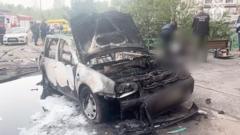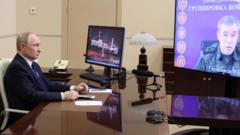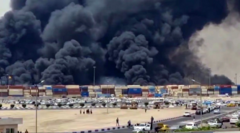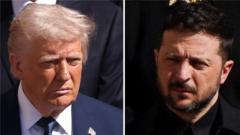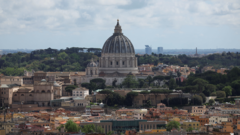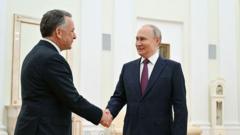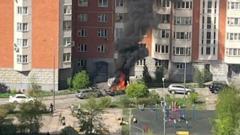A reported drone strike by Russian forces has hit the radiation shield of Chernobyl, prompting concerns over safety and stability. Ukraine maintains the incident poses a threat, while Russia denies responsibility. International monitoring agencies emphasize the need for caution.
Chernobyl's Radiation Shield Damaged by Reported Russian Drone Strike
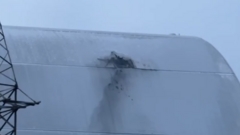
Chernobyl's Radiation Shield Damaged by Reported Russian Drone Strike
Ukrainian President Volodymyr Zelensky claims that a Russian drone has struck Chernobyl's protective cover, raising alarms about potential radiation leaks.
In a significant escalation in the ongoing Ukraine conflict, President Volodymyr Zelensky has reported that a Russian drone struck the protective structure over Chernobyl's damaged nuclear reactor. This event, occurring at the site of the 1986 nuclear disaster, resulted in a fire that has since been extinguished, but it raises serious concerns regarding potential radiation leaks. The International Atomic Energy Agency (IAEA) has asserted that radiation levels were normal and stable both inside and outside the Chernobyl facility immediately after the incident. However, Oleksandr Titarchuk, the chief engineer of the plant, warned that the possibility of radioactive substances escaping now exists.
Russia, however, has vehemently rejected these claims, asserting that its military does not target Ukrainian nuclear infrastructure and calling the allegations "not corresponding to reality." Following the explosion, IAEA personnel quickly responded, and the agency remains on high alert, with Director Rafael Grossi emphasizing the importance of vigilance in light of the dangerous circumstances.
Zelensky released footage purportedly showing damage to the concrete and steel shield, which was constructed to contain radioactive materials. Hryhoriy Ishchenko, head of the authority managing the Chernobyl exclusion zone, warned that a direct hit could have led to a significant radiation accident. Experts like Professor Jim Smith from the University of Portsmouth expressed concern over the attack but noted that the thick concrete structure beneath the compromised shield currently contains radioactive dust and particles from the original explosion.
Simon Evans, who previously managed the Chernobyl Shelter Fund, characterized the drone strike as an extremely reckless act against a vital safety installation. He indicated that while there appears to be substantial damage, further assessments are necessary to ascertain full repair costs.
The ramifications of this incident take on heightened importance in the context of ongoing military activities surrounding other nuclear facilities in Ukraine, particularly the Zaporizhzhia Nuclear Power Plant. Experts indicate that while Chernobyl's reactors are no longer active, the potential for conflict-related disturbances at operational sites like Zaporizhzhia could pose a more significant hazard.
The international community is watching closely as Ukraine and Russia engage in blame-shifting narratives over this latest incident, illustrating the fragile state of nuclear safety amid the war's upheaval. While Zelensky claimed the attack demonstrated Russia's unwillingness to negotiate, the attack on Chernobyl's defenses has reignited fears reminiscent of the catastrophic disaster's legacy.
Russia, however, has vehemently rejected these claims, asserting that its military does not target Ukrainian nuclear infrastructure and calling the allegations "not corresponding to reality." Following the explosion, IAEA personnel quickly responded, and the agency remains on high alert, with Director Rafael Grossi emphasizing the importance of vigilance in light of the dangerous circumstances.
Zelensky released footage purportedly showing damage to the concrete and steel shield, which was constructed to contain radioactive materials. Hryhoriy Ishchenko, head of the authority managing the Chernobyl exclusion zone, warned that a direct hit could have led to a significant radiation accident. Experts like Professor Jim Smith from the University of Portsmouth expressed concern over the attack but noted that the thick concrete structure beneath the compromised shield currently contains radioactive dust and particles from the original explosion.
Simon Evans, who previously managed the Chernobyl Shelter Fund, characterized the drone strike as an extremely reckless act against a vital safety installation. He indicated that while there appears to be substantial damage, further assessments are necessary to ascertain full repair costs.
The ramifications of this incident take on heightened importance in the context of ongoing military activities surrounding other nuclear facilities in Ukraine, particularly the Zaporizhzhia Nuclear Power Plant. Experts indicate that while Chernobyl's reactors are no longer active, the potential for conflict-related disturbances at operational sites like Zaporizhzhia could pose a more significant hazard.
The international community is watching closely as Ukraine and Russia engage in blame-shifting narratives over this latest incident, illustrating the fragile state of nuclear safety amid the war's upheaval. While Zelensky claimed the attack demonstrated Russia's unwillingness to negotiate, the attack on Chernobyl's defenses has reignited fears reminiscent of the catastrophic disaster's legacy.

